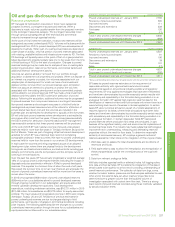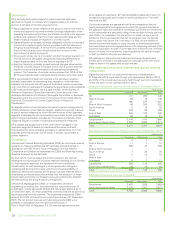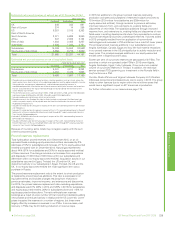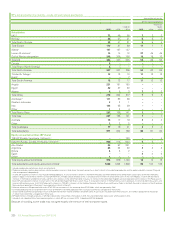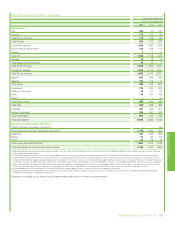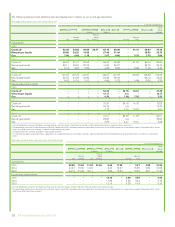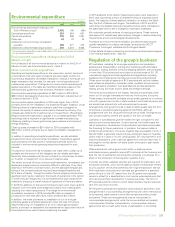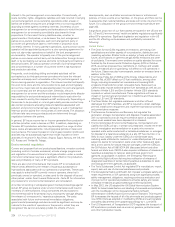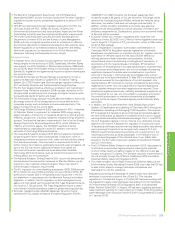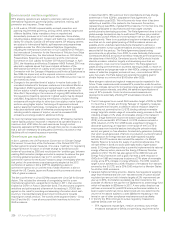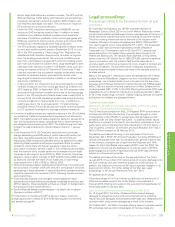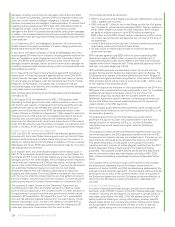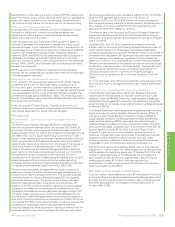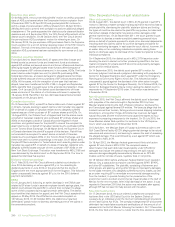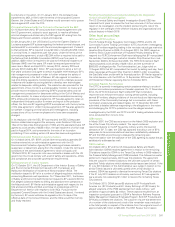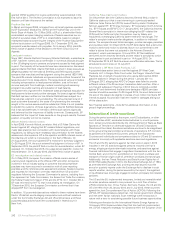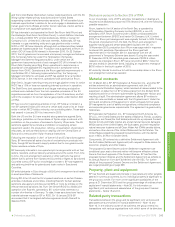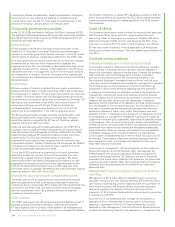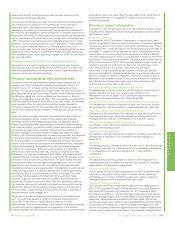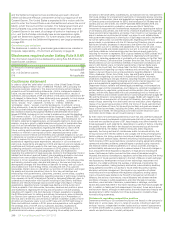BP 2015 Annual Report Download - page 241
Download and view the complete annual report
Please find page 241 of the 2015 BP annual report below. You can navigate through the pages in the report by either clicking on the pages listed below, or by using the keyword search tool below to find specific information within the annual report.
certain large GHG stationary emission sources. The EPA and the
National Highway Traffic Safety Administration are considering a
proposed rulemaking to extend and tighten GHG emission and
fuel efficiency standards until 2027. This will have an impact on
BP’s product mix and overall demand.
– Under the GHG mandatory reporting rule (GHGMRR), annual
reports on GHG emissions must be filed. In addition to direct
emissions from affected facilities, producers and importers/
exporters of petroleum products, certain natural gas liquids and
GHGs are required to report product volumes and notional GHG
emissions as if these products were fully combusted.
– The EPA proposed regulations establishing GHG emission limits
for new and modified power plants in September 2013. In June
2014, the EPA proposed a ‘Clean Energy Plan’ Regulation that
establishes GHG reduction requirements, at a state or regional
level, for existing power plants. The new and modified power
plant rule was finalized in August 2015 while the existing power
plant rule was finalized in October 2015. Legal challenges to both
rules have been filed by a number of US States; utility, coal, and
mining companies; and the US Chamber of Commerce. These
rules are important due to potential impacts on electricity prices,
reliability of electricity supply, precedents for similar rules
targeting other sectors and potential impacts on combined heat
and power installations.
– In January 2015, the US government announced plans to reduce
methane emissions from the oil and gas sector by 40-45% from
2012 levels by 2025. In September 2015, the EPA proposed rules
aimed at limiting methane emissions from the oil and natural gas
sector in the US with plans to finalize these rules in early 2016. In
January 2016, the BLM released proposed rules aimed at limiting
methane emissions on federal lands from new, modified and
existing sources in the oil and gas sector. If implemented as
proposed, these EPA and BLM rules will require further actions by
our US upstream businesses to manage methane emissions.
• A number of additional state and regional initiatives in the US will affect
our operations. California implemented a low-carbon fuel standard in
2010. The California cap and trade programme started in January 2012
with the first auctions of carbon allowances held in November 2012
and obligations commencing from 2013. The California cap and trade
programme was broadened to include transport fuels on 1 January
2015.
• In the November 2014 US-China joint announcement on climate
change addressing post-2020 actions, which was reaffirmed by the
countries’ respective presidents in 2015, the US committed to
reducing its GHG emissions by 26-28% below its 2005 level by 2025.
Achieving these reductions will require expanded efforts to reduce
emissions, which likely will include regulatory measures. China
announced it intends to achieve a peak in CO2emissions around 2030,
with the intention to try to peak earlier and to increase the non-fossil
fuel share of all energy to around 20% by 2030. Currently, China has
targets to reduce carbon intensity of GDP 40-45% below 2005 levels
by 2020 and increase the share of non-fossil fuels in total energy
consumption from 7.5% in 2005 to 15% by 2020.
• China is operating emission trading pilot programmes in five cities and
two provinces. A number of BP joint venture*companies in China are
participating in these schemes. A nationwide carbon emissions trading
market is expected to be launched in 2017 following the above seven
pilot programmes.
• China has also adopted more stringent vehicle tailpipe emission
standards and vehicle efficiency standards to address air pollution and
GHG emissions. These standards will have an impact on transportation
fuel product mix and overall demand.
• South Africa has delayed implementation of a carbon tax on carbon
intensive emitters until 2017.
For information on the steps that BP is taking in relation to climate
change issues and for details of BP’s GHG reporting see Environment
and society on page 46.
Legal proceedings
Proceedings relating to the Deepwater Horizon oil spill
Introduction
BP Exploration & Production Inc. (BPXP) was lease operator of
Mississippi Canyon, Block 252 in the Gulf of Mexico (Macondo), where
the semi-submersible rig Deepwater Horizon was deployed at the time of
the 20 April 2010 explosions and fire and resulting oil spill (the Incident).
The other working interest owners at the time of the Incident were
Anadarko Petroleum Company (Anadarko) and MOEX Offshore 2007
LLC, claims against whom were settled by BP in 2011. The Deepwater
Horizon, which was owned and operated by certain affiliates of
Transocean Ltd. (Transocean), sank on 22 April 2010. Lawsuits and
claims arising from the Incident have generally been brought in US
federal and state courts. The lawsuits have asserted, among others,
claims under the Oil Pollution Act of 1990 (OPA 90), claims for personal
injury in connection with the Incident itself and the response to it,
wrongful death, commercial and economic injury, breach of contract and
violations of statutes. The plaintiffs include individuals, corporations,
insurers and governmental entities and many of the lawsuits purport to
be class actions.
Many of the lawsuits in federal court were consolidated by the Federal
Judicial Panel on Multidistrict Litigation into two multi-district litigation
proceedings, one in federal district court in Houston for the securities,
derivative and Employee Retirement Income Security Act (ERISA) cases
(MDL 2185) and another in federal district court in New Orleans for the
remaining cases (MDL 2179). A Plaintiffs’ Steering Committee (PSC) was
established to act on behalf of individual and business plaintiffs in MDL
2179. These proceedings, and other material ongoing lawsuits and claims
arising from the Incident are discussed below.
Federal and state claims
MDL 2179 – Department of Justice (DoJ) Action and Trial of Liability,
Limitation, Exoneration and Fault Allocation
The US filed a civil complaint in MDL 2179 against BPXP and others on
15 December 2010 (the DoJ Action). The complaint sought an order
finding liability under OPA 90 for natural resources damages and civil
penalties under the Clean Water Act (CWA). To address certain issues
asserted in or relevant to the claims, counterclaims, cross-claims, third-
party claims, and comparative fault defences raised in the DoJ Action, a
Trial of Liability, Limitation, Exoneration and Fault Allocation (the Trial) in
MDL 2179 commenced on 25 February 2013.
The district court issued its ruling on the first phase of the Trial in
September 2014. BPXP, BP America Production Company (BPAPC) and
various other parties were each found liable under general maritime law
for the blowout, explosion and oil spill from the Macondo well. With
respect to the United States’ claim against BPXP under the CWA, the
district court found that the discharge of oil was the result of BPXP’s
gross negligence and wilful misconduct and that BPXP was therefore
subject to enhanced civil penalties.
The district court issued its ruling on the second phase of the Trial in
January 2015. It found that 3.19 million barrels of oil were discharged into
the Gulf of Mexico and were therefore subject to a CWA penalty. In
addition, the district court found that BP was not grossly negligent in its
source control efforts. For further details of the Trial, see ‘Legal
proceedings’ in BP Annual Report and Form 20-F 2014.
BP appealed both rulings.
The penalty phase of the Trial involved consideration of the amount of
CWA civil penalties owed to the United States, and concluded in
February 2015. Briefing concluded on the post-trial briefing schedule for
the penalty phase on 24 April 2015.
State and local authority claims consolidated into MDL 2179
On 12 August 2010, the State of Alabama filed a lawsuit seeking
damages for alleged economic and environmental harms, including
natural resource damages, civil penalties under state law, declaratory and
injunctive relief, and punitive damages as a result of the Incident.
On 3 March 2011, the State of Louisiana filed a lawsuit to declare various
BP entities (as well as other entities) liable for removal costs and
Additional disclosures
*Defined on page 256. BP Annual Report and Form 20-F 2015 237


